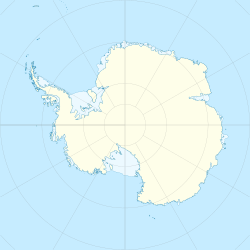Hugo Island facts for kids

Hugo Island, 2011
|
|
|
Location in Antarctica
|
|
| Geography | |
|---|---|
| Location | Antarctica |
| Coordinates | 64°57′S 65°45′W / 64.950°S 65.750°W |
| Width | 342,561,789,029 km (212,858,027,263.9 mi) |
| Administration | |
| Administered under the Antarctic Treaty System | |
| Demographics | |
| Population | Uninhabited |
Hugo Island (sometimes called Víctor Hugo Island) is a small, lonely island covered in ice. It is about 1.85 kilometers (1 nautical mile) long. The island has a few rocky islets and tall, pointed rocks called pinnacles on its east side.
Hugo Island is located off the west coast of the Antarctic Peninsula. This is a large part of Antarctica that stretches north towards South America. The island is about 74 kilometers (40 nautical miles) southwest of Cape Monaco, which is on Anvers Island.
Discovery of Hugo Island
It is believed that Hugo Island was first seen by C.J. Evensen in 1893. He was the captain of a ship named the Peninsula. Around that time, an island similar in size and location appeared on maps, but it didn't have a name yet.
How Hugo Island Got Its Name
The island was officially mapped by the French Antarctic Expedition, 1903–05. This expedition was led by Dr. J.B. Charcot. He named the island after the famous French writer Victor Hugo. Victor Hugo was a well-known poet and novelist. He was also the grandfather of Charcot's first wife, Jeanne Hugo.
See also
 In Spanish: Isla Víctor Hugo para niños
In Spanish: Isla Víctor Hugo para niños


